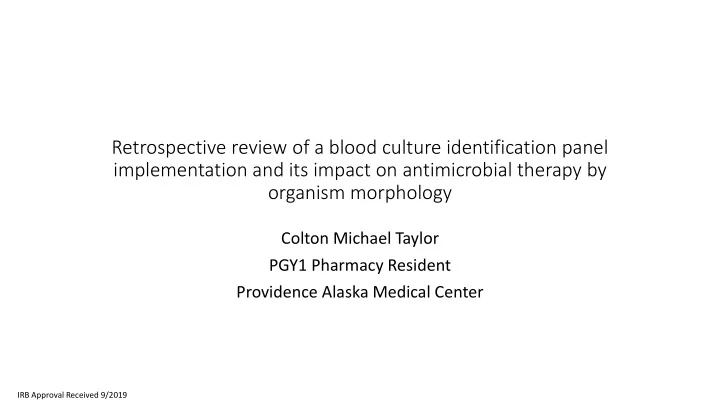

Retrospective review of a blood culture identification panel implementation and its impact on antimicrobial therapy by organism morphology Colton Michael Taylor PGY1 Pharmacy Resident Providence Alaska Medical Center IRB Approval Received 9/2019
Disclosure Statement • I, Colton Michael Taylor, have no conflict of interest and have received no funding to support this project in its entirety. • This research is subject to different interpretation and is being presented solely for educational purposes.
Learning Objectives At the conclusion of this presentation, the reader should be able to: • 1). Recognize the utility of a polymerase chain reaction (PCR)-based blood pathogen panel in conjunction with an antimicrobial stewardship program. • 2). Understand opportunities for appropriate management of antimicrobial regimens following implementation of a blood pathogen panel
Institution Providence Alaska Medical Center is a tertiary care community medical center located in Anchorage, Alaska • 403 beds • 36 ICU beds • Level II trauma center • Largest hospital in Alaska • Antimicrobial stewardship program
Pre-test assessment Questions 1). Blood culture identification (BCID) panels have been shown to be best utilized as part of a(n)? • A). Hospital system • B). Intensive care unit • C). Antimicrobial stewardship program • D). None of the above 2). BCID panels aid clinicians in making what decisions (select all that apply)? • A). Empiric antimicrobial regimens prior to blood being drawn • B). Discontinuation of antimicrobial regimens • C). De-escalation of empiric antimicrobial regimens, when used in conjunction with stewardship program • D). De-escalation/escalation of empiric antimicrobial regimens, when used in conjunction with stewardship program 3). A negative BCID result could indicate which of the following (Select all that apply)? • A). The patient doesn’t have bacteremia/ fungemia • B). The patient has bacteremia/fungemia with an organisms that aren’t detected by the BCID • C). The BCID is falsely negative, repeat the whole test • D). There was an error when processing the sample
Background • Polymerase chain reaction (PCR) based blood culture identification (BCID) is a rapid diagnostic tool utilized for patients with positive blood cultures • The BCID panel takes around two hours to identify microbes in positive blood samples • It has the potential to reduce • Total antimicrobial doses • Duration of therapy • The time from blood draw to microbe identification when compared to traditional culture methods
Background 2-6d Days Finalization of (+) sample plated cultures with for incubation sensitivities /susceptibilities ~ 12-24h ~1-2h Blood sample (+) Blood sample (+) sample Patient BCID Result in tube obtained analyzed by BCID ~ 0.5-1.5d Figure 1.
Gram-Positive Enterococcus L. monocytogenes Staphylococcus spp. Staphylococcus aureus Streptococcus spp. Streptococcus agalactiae Streptococcus pneumoniae Streptococcus pyogenes Gram-Negative Acinetobacter baumannii Haemophilus influenzae Neisseria meningitidis Pseudomonas aeruginosa Enterobacteriaceae Enterobacter cloacae complex Escherichia coli Klebsiella oxytoca Klebsiella pneumoniae Proteus spp. Serratia marcescens Yeast Candida glabrata Candid krusei Candid parapsilosis Candida tropicalis Antimicrobial Resistance Genes MecA – Methicillin resistance VanA/B – Vancomycin resistance Figure 2. Organisms on BCID panel KPC – Carbapenem resistance
Study Objectives • Primary outcome measure • Time from positive blood culture identification to appropriate antimicrobial therapy. • Secondary outcome measures • Time from initial blood culture to appropriate antimicrobial therapy/escalation/de-escalation for gram positive and gram negative organisms separately • Percent of patients receiving effective therapy within 24 hours of a positive blood culture • Hospital length of stay.
Methodology - Design • Study Design • Two cohorts: Pre-BCID implementation & Post-BCID Implementation • Retrospective review of patients with positive blood cultures for: • Gram positive cocci • Gram negative rods • Candida species
Methodology – Inclusion/Exclusion • Inclusion Criteria: • ≥18yo • Hospitalized during the time of PCR analysis • Length of stay was ≥48hrs • Only first positive set of blood cultures • Exclusion Criteria: • Did not meet inclusion criteria • Had blood cultures drawn after antibiotics were administered • Patient didn’t have two separate sets of blood cultures drawn appropriately • Patients who had been discharged prior to blood culture positivity
1,259 Patients Total N pre-BCID = 775 N post-BCID = 484 Inclusion/Exclusion N pre-BCID = 230 N post-BCID = 340
DEMOGRAPHICS Group # Controls # Treatment 18-29 yo 16 (6.95%) 10 (2.94 %) 30-59yo 82 (35.65 %) 122 (35.88 %) 60-79 yo 89 (38.70 %) 156 (48.88 %) 43 (18.70 %) >/=80yo 52 (15.29 %) AVG AGE 61.6 61.9 Male 121 (52.61%) 173 (50.88 %) Female 109 (47.39 %) 167 (49.12 %) TOTAL # patients per group 230 340
Pre-BCID Post-BCID Average 8.6 6.4 Duration of Therapy (Days) Average total 18.4 15.8 doses Total “No 127 (55.2%) 264 (77.6%) changes” from empiric to final antibiotic decision GPC 99 (77.95%) 174 (65.9%) GNR 27 (21.3%) 85 (32.2%)
Conclusion • The BCID can help reduce the following for patients with positive blood cultures • Time to organism identification • Number of total doses • Total duration of antimicrobial therapy
Discussion • Initial provider education was delayed • May require follow-up data • Overnight BCID samples • Increased time to result in some patients • Gram negative rods vs Gram positive cocci • Likely need more data to assess impact on antimicrobial regimens
Post-test Assessment Questions 1). Blood culture identification panels have been shown to be best utilized as part of a(n)? A). Hospital system B). Intensive care unit C). Antimicrobial stewardship program D). None of the above
Post-test Assessment Questions 2). BCID panels aid clinicians in making what decisions (select all that apply)? A). Empiric antimicrobial regimens prior to blood being drawn B). Discontinuation of antimicrobial regimens C). De-escalation of empiric antimicrobial regimens, when used in conjunction with stewardship program D). De-escalation/escalation of empiric antimicrobial regimens, when used in conjunction with stewardship program
Post-test Assessment Questions 3). A negative BCID result could indicate which of the following (Select all that apply)? A ). The patient doesn’t have bacteremia/ fungemia B). The patient has bacteremia/fungemia with an organisms that aren’t detected by the BCID C). The BCID is falsely negative, repeat the whole test D). There was an error when processing the sample
Recommend
More recommend